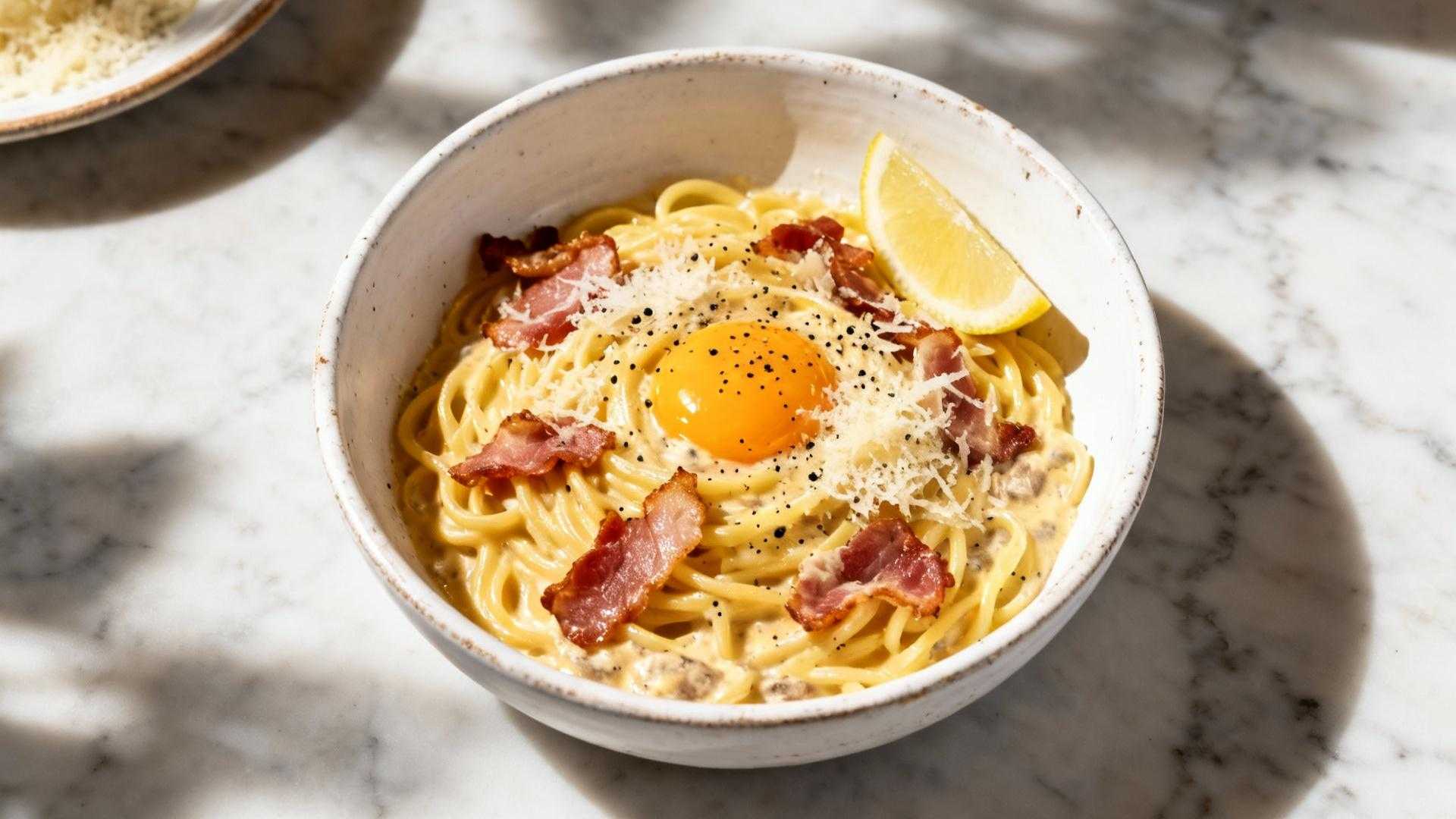Picture yourself twirling a fork through a perfect plate of carbonara, the creamy sauce coating each strand of pasta. But wait—should that sauce be creamy at all? The great carbonara debate has divided food lovers across continents, with Italians defending their traditional recipe while French cooks embrace a richer variation. Understanding this culinary divide might just transform your next pasta night.
The Italian way: simplicity speaks volumes
Traditional Italian carbonara relies on just five ingredients: eggs, guanciale (cured pork jowl), Pecorino Romano cheese, black pepper, and pasta. No cream appears anywhere in the authentic recipe. The sauce’s silky texture comes from carefully tempering egg yolks with hot pasta water—a technique that requires practice but delivers remarkable results.
Maria Lombardi, a Roman chef teaching at the Culinary Institute of Rome, explains the philosophy behind this approach. “Our grandmothers created carbonara from humble ingredients during difficult times. The beauty lies in coaxing maximum flavor from minimal components.”
“Carbonara isn’t about adding richness—it’s about revealing the natural harmony between eggs, cheese, and pork. When you add cream, you mask these delicate flavors rather than celebrating them.” — Maria Lombardi, Chef Instructor at Culinary Institute of Rome
France’s creamy interpretation
French cooks approach carbonara differently, often incorporating crème fraîche for a lusher, more forgiving sauce. This adaptation emerged partly from ingredient availability—guanciale proves harder to find in French markets, so lardons (bacon pieces) frequently substitute. The cream addition creates a sauce that’s easier to execute for home cooks without risking scrambled eggs.
For Americans interested in exploring simple cooking techniques, both approaches offer valuable lessons in building flavor through technique rather than complexity.
Why the debate matters more than you think
This isn’t just about pasta—it reflects how we value culinary authenticity versus adaptation. Italian purists view carbonara as cultural heritage worth preserving exactly as created. French adaptations demonstrate how recipes evolve when they cross borders, incorporating local ingredients and preferences.
Chef Antoine Moreau from Lyon’s École de Cuisine Française offers perspective: “Both versions have merit. The Italian teaches restraint and technique. The French version shows how tradition can accommodate modern convenience without losing soul.”
Key differences that define each version
Understanding these distinctions helps you choose which style suits your preferences and skill level. The Italian method demands more technique but delivers lighter, more nuanced flavors.
- Italian version: Uses only egg yolks, creates sauce through emulsification with pasta water, features guanciale’s distinctive pork flavor, and results in a lighter, coating-style sauce
- French version: Incorporates crème fraîche for guaranteed creaminess, substitutes readily available lardons, offers more forgiving preparation, and produces a richer, heavier dish
The ingredient quality question
Regardless of which style you choose, ingredient quality dramatically impacts results. Premium Pecorino Romano cheese brings sharp, salty depth that pre-grated alternatives can’t match. Fresh eggs with bright orange yolks create more vibrant color and richer flavor than standard supermarket options.
Similar to how quality ingredients transform simple preparations, investing in authentic guanciale or artisanal lardons elevates your carbonara from ordinary to memorable.
Making the technique work for you
The Italian method intimidates many home cooks, but mastering it opens doors to countless other egg-based sauces. The key lies in temperature control—removing pasta from heat before adding eggs prevents scrambling while maintaining enough warmth to create sauce.
“Think of the egg-based sauce like a warm custard. You’re not cooking the eggs so much as gently warming them until they thicken around the pasta. Patience and low heat are your friends here.” — Chef Pierre Dubois, French Culinary Academy
What sustainability teaches us
Choosing between these styles also touches on environmental considerations. The Italian version typically produces less waste and requires fewer ingredients. However, sourcing local cream and pork products in France reduces transportation impacts compared to importing Italian guanciale.
Those exploring sustainable eating habits might appreciate how both versions can work within locally-sourced ingredient frameworks.
Which version deserves your fork tonight?
Maybe the real question isn’t which carbonara is “better” but which serves your current needs. Craving authentic tradition and willing to practice technique? The Italian way rewards your patience with sophisticated simplicity. Need a reliable weeknight dinner that delivers creamy comfort? The French approach offers delicious insurance against culinary mishaps. What matters most is cooking with intention, respecting ingredients, and enjoying the result—isn’t that what great food is really about?
